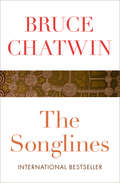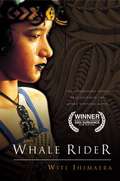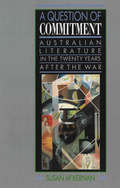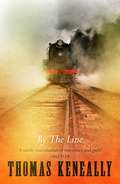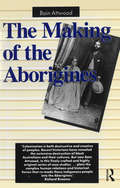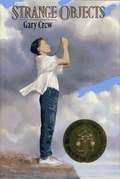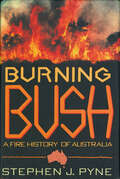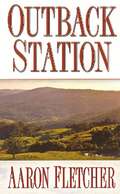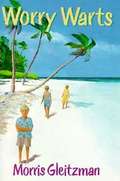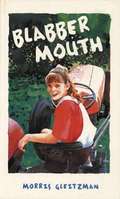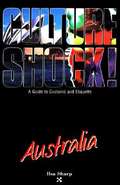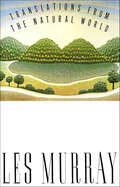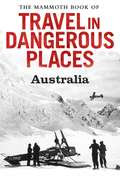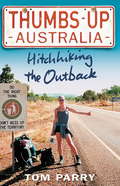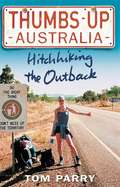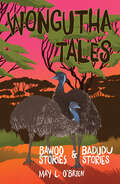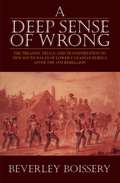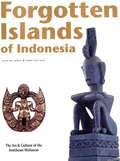- Table View
- List View
The Songlines (Picador Bks.)
by Bruce ChatwinInternational Bestseller: The famed travel writer and author of In Patagonia traverses Australia, exploring Aboriginal culture and song—and humanity&’s origins. Long ago, the creators wandered Australia and sang the landscape into being, naming every rock, tree, and watering hole in the great desert. Those songs were passed down to the Aboriginals, and for centuries they have served not only as a shared heritage but as a living map. Sing the right song, and it can guide you across the desert. Lose the words, and you will die. Into this landscape steps Bruce Chatwin, the greatest travel writer of his generation, who comes to Australia to learn these songs. A born wanderer, whose lust for adventure has carried him to the farthest reaches of the globe, Chatwin is entranced by the cultural heritage of the Aboriginals. As he struggles to find the deepest meaning of these ancient, living songs, he is forced to embark on a much more difficult journey—through his own history—to reckon with the nature of language itself. Part travelogue, part memoir, part novel, The Songlines is one of Bruce Chatwin&’s final—and most ambitious—works. From the author of the bestselling In Patagonia and On the Black Hill, a sweeping exploration of a landscape, a people, and one man&’s history, it is the sort of book that changes the reader forever. This ebook features an illustrated biography of Bruce Chatwin including rare images and never-before-seen documents from the author&’s estate.
Whale Rider
by Witi IhimaeraEight-year-old Kahu, a member of the Maori tribe of Whangara, New Zealand, fights to prove her love, her leadership, and her destiny. Her people claim descent from Kahutia Te Rangi, the legendary "whale rider." In every generation since Kahutia, a male heir has inherited the title of chief. But now there is no male heir, and the aging chief is desperate to find a successor. Kahu is his only great-grandchild--and Maori tradition has no use for a girl. But when hundreds of whales beach themselves and threaten the future of the Maori tribe, it is Kahu who saves the tribe when she reveals that she has the whale rider's ancient gift of communicating with whales.
A Question of Commitment: Australian literature in the twenty years after the war
by Susan LeverIn the years since the Second World War, Australia has seen a period of literary creativity which outshines any earlier period in the nation's literary history. This creativity has its beginnings in the arguments and alignments which emerged at the end of the War, and the changes in perceptions of art and society which occurred during the fifties and early sixties.A Question of Commitment examines the attitudes of writers as diverse as James McAuley, Frank Hardy, Judith Wright, Patrick White and A. D. Hope, as they responded to a changing Australian society during the postwar years. Through their work and that of many others, it considers the debates about literary nationalism, the artistic politics of the Cold War, the threat of technology to art in the Atomic Age, and the nature of the writer's role in the new society. It documents the way in which the political commitments of some writers and the resistance to commitment of others were challenged by political and social changes of the late fifties.Susan McKernan's lively exploration of Australia's writers in a time of innovation provides the reader with the context needed to understand the creative choices they made and, in so doing, introduces wider intellectual and cultural issues which remain relevant to this day.
By the Line
by Thomas KeneallySchoolboy narrator Daniel Jordan, growing up in working-class Sydney during the Second World War, is confused by a world in which the religious dogma of his school conflicts with the communism of his family's terrifying neighbour, the 'Comrade'. Refreshingly unsentimental, this is the funny, ultimately tragic story of a boy struggling to understand a world in which concepts like innocence and guilt, good and evil are clearly open to interpretation.
The Making of the Aborigines
by Bain AttwoodBefore 1788, the peoples of this continent did not consider themselves 'Aboriginal'. They only became 'Aborigines' in the wake of the British invasion. In this startling and original study, Bain Attwood reveals how relationships between black Australians and European colonisers determined the hearts and minds of the indigenous peoples, making them anew as Aboriginals.In examining the period after the 'killing times', this young historian provides new perspectives on racial ideology, government policy, and the rule of law. In examining European domination, he unravels the patterns of associations which were woven between European and Aborigine, and shows the complex meanings and significance these relationships held for both groups.In this book, the dispossessed are not cast as merely passive victims; they appear as real characters, men and women who adapted to European colonisation in accordance with their own historical and cultural experience. Out of this exchange the colonised created a new consciousness and began to forge a common identity for themselves.A story of cultural change and continuity both poignant and disturbing in its telling, this important book is sure to provoke controversy about what it means to be Aboriginal.'This intelligent and impeccably researched book seeks to advance our understanding of the story of white/Aboriginal contact. It will be required reading for anyone working in the field.' - Henry Reynolds'Colonisation is both destructive and creative of peoples. Recent historians have revealed the extensive destruction of black Australians and their cultures. But now Bain Attwood, in this finely crafted and highly original series of case studies. plots the complex human relations and historical forces that re-made these indigenous people into the Aborigines.' - Richard Broome
Strange Objects
by Gary CrewAfter discovering valuable relics from a seventeenth-century shipwreck, a sixteen-year-old Australian disappears under mysterious circumstances.
Burning Bush: A Fire History of Australia (Weyerhaueser Cycle Of Fire Ser.)
by Stephen J. PyneFrom the time of the continent's formation tens of millions of years ago as the Godwana twin of Antarctica, Australia has been dominated by fire much as its sister has been by ice. Now Stephen Pyne, one of our foremost environmental historians, proposes a major reinterpretation of the Australian experience by using fire and Australia to explain one another. He narrates the story of how fire came to Australia and interacted with the Australian biota and its human inhabitants, while at the same time he relates the planetary saga of fire as it has been played out on this special island continent. Much as the Aborigines exploited fire to remake their environment into something more usable, so Stephen Pyne exploits fire to transform the landscape of history into something more accessible, to use its transmuting power to extract new meaning out of familiar events. Pyne traces the impact of fire, from its initial influence on the evolving vegetation of the new continent, through its use by the Aborigines and the subsequent European settlers, to the holocaust of February 1983 known as Ash Wednesday, and he shows us that the dynamic nature of fire has made it a most powerful environmental determinant in Australia, shaping both its social and natural histories. In his critically acclaimed study of Antarctica, The Ice, Pyne explored the myriad dimensions of the cold continent; now Burning Bush offers us an equally absorbing examination of a continent informed by fire.
Misery Guts
by Morris GleitzmanThe adventures of twelve-year-old Keith as he tries to cheer up his parents in many different ways include painting their shop in bright colors and convincing them to move from gloomy England to a place called Paradise.
Outback Station (Outback Saga #2)
by Aaron FletcherThe Convict: David Kerrick is a man with nothing left to lose. Betrayed by the woman he adores, deported to Australia for murdering her lover, he has lost the will to live until the lure of the outback claims his soul. Captivated by the sweeping wild beauty of the land, its freedom and mystery, he sets out to make a piece of it his own. Battling drought and dingoes, bushfires and bushrangers, he lives for the moment until the past comes back to haunt him... The Colonist: Wealthy and beautiful, Alexandra Hammond has every reason to disdain the penniless convict who has killed her cousin. But Alexandra is a woman with the strength to judge the truth for herself, and the determination to forge her own destiny. Together, they will take on the vast outback, burying the bitterness of the past and planting the seeds of a shining future.
Worry Warts
by Morris GleitzmanWorried because his parents' constant fighting has been aggravated by their financial troubles, twelve-year-old Keith decides to solve the problem by running away to pick up a fortune in the Australian opal fields.
Blabber Mouth
by Morris GleitzmanSet in Australia, this humorous and touching story of the misadventures of a clever girl who cannot speak and her social misfit of a father will delight readers.
Culture Shock! Australia
by Ilsa SharpIn addition to explaining Australia to newcomers and visitors in the hope of bridging culture gaps and improving the chances of mutual empathy and friendship, it is the author's wish that Australians will, through this book, see themselves through outsiders' eyes.
Transit of Venus
by Julian EvansJulian Evans won a host of awards for this smart, funny, and thoughtful travelogue through the South Pacific islands. Evans was raised in Australia, but moved to England as a teenager, and forever longed to return to the Pacific of his childhood. He sails on a freighter from Australia to cross the Pacific, stopping at a series of ever more remote islands. Along the way he discusses the politics, history, and culture of the Pacific Islanders and the Europeans with whom they so uneasily co-exist. English, not American, spelling and punctuation; also dialect here and there
Translations from the Natural World: Poems
by Les MurrayThe centerpiece of this collection of poems is "Presence," a sequence of forty "translations from the natural world" about a variety of settings and their amazing denizens. Lyre birds, honeycombs, sea lions, possums, all act as spurs for Murray's protean talent for description and imitation."Even with a score of volumes and a king's ransom of literary honors to his credit, Australian poet Murray refuses to take words for granted. His latest collection is a forceful blend of formalism and experimentation, a test of imagination, ear, and tongue for both poet and reader." - Library Journal
Hestorian Taotao Tano': History of the Chamorro People
by Political Status Education Coordinating CommissionCONTENTS PART I: CHAMORRO PREHISTORY Introduction UNIT 1: The Quest for a Home and Identity Section A Clues to the Puzzle Clues from Ancestral Remains Clues from Language Clues from Tools and Pottery Clues from Plants Putting the Clues Together Section B Looking for a Home Section C The Pacific Section D The Navigators Section E Settlements UNIT 2: The Life of the Ancient Chamorros Section A Economics and Society Section B Home and Family Section C The Manmaga'lahi and Manmaga'haga Section D The Guma' Uritao Section E Marriage and Home Section F Beliefs Section G Magic and Medicine PART II: CONTACT WITH THE EUROPEANS Introduction UNIT 1: Contact with the Europeans Section A A Tale about How it might have Happened Section B The Search for Wealth and Power Section C Conversion, Conquest and Colonization Section D The Religion of the Chamorros UNIT 2: Bringing Christianity to the Chamorros Section A Padre San Vitores and the Chamorros Section B Trouble Over Differences Section C Chamorro Leaders Who Rebelled Section D Guam in the 18th and 19th Centuries Section E The Continuing Role of Chamorro Women English Glossary Chamorro Glossary
The Champion
by Maurice GeeIn 1943 twelve-year-old Rex sees his quiet New Zealand village dramatically changed by the arrival of a black American soldier on leave from the war.
The Mammoth Book of Travel in Dangerous Places: Australia (Mammoth Books #348)
by John KeayLandfall at Botany Bay - James CookThe son of a Yorkshire farm labourer, Cook won distinction as a naval hydrographer but was still a controversial choice to command a voyage of scientific observation to the Pacific in 1768. Its results, including the first coastal surveys of New Zealand and eastern Australia, led to a second voyage to the south Pacific and a third to the north Pacific, during which he was killed in a fracas with the Hawaiians. It was a tragic end for one whose humble origins disposed him to respect indigenous peoples. "They are far happier than we Europeans", he noted of Australia's aborigines following a brief encounter at Botany Bay (Sydney), the first European landing on the Pacific coast, in 1770.Escape from the Outback - Charles SturtAfter pioneering journeys to the Darling and Murray rivers, in 1844-5 Sturt headed north for the heart of Australia. Since the continent appeared to have few seaward draining rivers it was assumed that, alike Africa, it must boat an inland lake region; a boat was therefore included amongst the expeditions equipment. But Sturt failed to reach the geographical centre of the continent, and the largest stretch of water found was at Coopers Creek, later to figure so prominently in the endeavours of Burke and Wills. Sturt's painful retreat during the hottest summer on record formed a fitting prelude to the Wills saga.Death at Coopers Creek - William John WillsIn early 1861 Robert O'Hara Burke, William Wills and John King reached Australia's northern coast on the Gulf of Carpentaria, thus completing the first transcontinental crossing. Returning the way they had come, after four months of appalling hardship they staggered into Sturt's Coopers Creek where men and supplies had been left to await their return. They were just eight hours too late; the relief party, despairing of their return, had left that very morning. One of exploration's most poignant moments was followed by one of its most protracted tragedies as the expedition tried to extricate itself, failed, faded, and died. Only King survived; three months later he was discovered living with the aborigines; Will's heartbreaking journal was found lying beside his skeleton.To See the Sea - John McDouall StuartModest, dedicated, immensely tough and thoroughly congenial, Stuart was very much an explorer's explorer. With little support or fuss he began probing north from Adelaide in the late 1850's. In 1860 he was the first to reach the centre of the continent, thus completing the work of Sturt. Although Burke and Wills just beat him in the race to cross the continent, Stuart's 1862 route was much longer and more difficult; and he did actually reach the sea. He was also to return alive.
Thumbs Up Australia
by Tom ParryWith anecdotes and endearing tales of characters met along the way, Thumbs Up Australia follows the exploits of an English hitchhiker and his reluctant French girlfriend as the two uncover a never-before-seen Australia. Tom Parry carries the reader through almost-empty highways and a distinctively Aussie society on a journey of 8,000 miles-with just as many adventures.
Thumbs Up Australia: Hitchhiking the Outback
by Tom ParryOn the Road meets Down Under in this really rough guide to the adventures of an enthusiastic hitchhiker and his reluctant girlfriend on their quest for the real Australia. Hitching lifts with the desert's dodgiest drivers and taking breaks in the roughest roadhouses, this is Tom Parry's witty, warts-and-all tale of hitchhiking 8,000 miles across - and around - the Australian outback with his thumb, his backpack and his French girlfriend, Katia. As the couple hitch their way around the near empty highways, they encounter as wide a cross-section of Aussie society as you could ever hope to meet. In cattle stations, Aboriginal communities, remote waterholes, caravan parks, hippy communes and roadhouses, they see a country that remains as extraordinary today as it was for the first nineteenth century settlers. Loosely following the routes carved out by the legendary explorers who first traversed the great continent, the couple get to grips with the country's fascinating history. Set against a backdrop of the real Australia - not 'as seen on TV'- "Thumbs Up Australia" is full of wonderful anecdotes and endearing tales of some of the country's most idiosyncratic characters, from the grizzled Aboriginal elder with his tales of dreamtime, to an amphetamine-swallowing road train driver. And at the end of their journey, it is ironically Katia who suggests thumbing a lift to the airport!
Wongutha Tales
by May O'BrienFirst published as individual titles in 1992, May O' Brien' s stories were ground-breaking publications, presenting traditional Indigenous stories in a bilingual text and giving a unique insight into learning English as a second language from a First Nations perspective. Classic tales such as How Crows Became Black and Why the Emu Can' t Fly are still as fresh and appealing as ever for a new generation of junior readers. Plus May' s simple pronunciation guide for Wongutha words are perfect learning activities for the classroom.
A Deep Sense of Wrong: The Treason, Trials and Transportation to New South Wales of Lower Canadian Rebels
by Beverley BoisseryIn 1839 fifty-eight men left Montreal for the penal colony of New South Wales. They were ordinary people who had been caught up in the political whirlwind of the 1838 rebellion. Even though they were all civilians, they had been tried by court martial. Convicted of treason, their properties forfeited to the crown, they paid a heavy price for rebellion. And as convicts in Australia, they were considered the lowest of a bad lot. During their years there, however, they earned the respect of Sydney’s citizens.
Forgotten Islands of Indonesia
by Joss Van Dijk Nico DejongeThis beautiful book contains over 170 unique photographs and pictures of one of the most interesting but least well known cultures in the Indonesian Archipelago.The traditional art of Maluku Tenggara, the Southeast Moluccas, is among the most sophisticated and expressive in the world. Simple tools were used to create masterpieces in wood, stone, textiles and precious metals, while the plaited work and earthenware of these islands are also of the very highest quality.the colonial period plunged the region into hopeless isolation. During the harsh rule of the Dutch many traditional woks of art, especially ancestor statues, were destroyed. Later, collectors stripped the islands of their masterpieces and the culture of Maluka Tenggara was forgotten.Forgotten Islands of Indonesia presents a unique survey of the finest examples of Southeast Moluccan art. This volume contains many photographs and descriptions which have never before been published. Set against the cultural background and supplemented by rare photographs taken in the field, the material culture of Maluku Tenggara, which is regarded as one of the most fascinating areas of Indonesia, is presented here comprehensively for the first time.
Forgotten Islands of Indonesia
by Joss Van Dijk Nico DejongeThis beautiful book contains over 170 unique photographs and pictures of one of the most interesting but least well known cultures in the Indonesian Archipelago.The traditional art of Maluku Tenggara, the Southeast Moluccas, is among the most sophisticated and expressive in the world. Simple tools were used to create masterpieces in wood, stone, textiles and precious metals, while the plaited work and earthenware of these islands are also of the very highest quality.the colonial period plunged the region into hopeless isolation. During the harsh rule of the Dutch many traditional woks of art, especially ancestor statues, were destroyed. Later, collectors stripped the islands of their masterpieces and the culture of Maluka Tenggara was forgotten.Forgotten Islands of Indonesia presents a unique survey of the finest examples of Southeast Moluccan art. This volume contains many photographs and descriptions which have never before been published. Set against the cultural background and supplemented by rare photographs taken in the field, the material culture of Maluku Tenggara, which is regarded as one of the most fascinating areas of Indonesia, is presented here comprehensively for the first time.
Forgotten Islands of Indonesia: The Art & Culture of the Southeast Moluccas
by Joss Van Dijk Nico DejongeThis beautiful book contains fascinating text and over 170 unique photographs of one of the most interesting but least well known cultures in the Indonesian Archipelago.The traditional art of Maluku Tenggara, the Southeast Moluccas, is among the most sophisticated and expressive in the world. Simple tools were used to create masterpieces in wood, stone, textiles and precious metals, while the plaited work and earthenware of these islands are also of the very highest quality.the colonial period plunged the region into hopeless isolation. During the harsh rule of the Dutch many traditional woks of art, especially ancestor statues, were destroyed. Later, collectors stripped the islands of their masterpieces and the culture of Maluka Tenggara was forgotten.Forgotten Islands of Indonesia presents a unique survey of the finest examples of Southeast Moluccan art. This volume contains many photographs and descriptions which have never before been published. Set against the cultural background and supplemented by rare photographs taken in the field, the material culture of Maluku Tenggara, which is regarded as one of the most fascinating areas of Indonesia, is presented here comprehensively for the first time.
